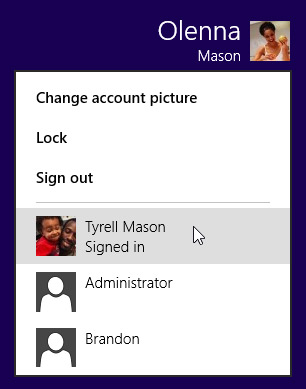
A user account allows you to sign in to your computer. By default, your computer already has one user account, which you were required to create when you set up your computer. If you plan share your computer with others, you can create a separate user account for each person.
Why use separate
user accounts?
At this
point, you may be wondering why you would even need to use separate user
accounts. But if you’re sharing a computer with multiple people––for example,
with your family or at the office––user account allow everyone to save their own files, preferences, and settings
without affecting other computer users. When you start your computer, you’ll be
able to choose which account you use.

Administrator,
standard, and managed accounts
Before you
create new user account, it’s important to understand the different types.
▶ Administrator: Administrator account are special
accounts that are used for making changes to system settings or managing other
people’s accounts. They have full access to every setting on the computer.
Every computer will have at least one Administrator account, and if you’re the
owner you should already have a password to this account.
▶ Standard: Standard accounts are the basics accounts
you use for normal everyday tasks. As a Standard user, you can do just about anything
you would need to do, such as running software or personalizing your desktop.
▶ Standard with Family Safety: These are the only accounts that can
have parental controls. You can
create a Standard account for each child, then go to the Family Safety settings in your Controls
Panel to set website restrictions, time limits, and more.
Generally,
it’s safer to be signed in to a Standard account than an Administrator account.
If you’re logged in as an Administrator, it may actually make it easier for an unauthorized user to make changes to
your computer. Therefore, you may want to create a Standard account for
yourself, even if you’re not sharing the computer with anyone. You’ll still be
able to make Administrator-level changes;
you’ll just need to provide your Administrator
password when making these changes.
Switching between
user accounts
If you have multiple
user accounts on your computer, it’s easy to switch between users without signing out or closing your computer
apps. Switching users will lock the
current user, so you won’t need to worry about someone else accessing your
account.
To switch between
user accounts (windows 10):
Click the current user icon on the left side of
the Start menu, the select the desired user from the drop-down menu.
The user will then need to enter a
password to sign in.

To switch
between user accounts (windows 8):
Click the current user in the upper-right of the Start screen, then select the desired user from the drop-down menu.
The user will then need to enter a
password to sign in.

v You can switch back by selecting the desired user form the drop-down menu.
You’ll need to re-enter your password
to unlock the account.

To switch
between user accounts (windows 7):
Click the Start button, click the arrow next to Shout Down, and select Switch user.

v If you’re finished using the
computer, you can also choose to log off.
This will allow other users to sign in to the computer with different accounts.




